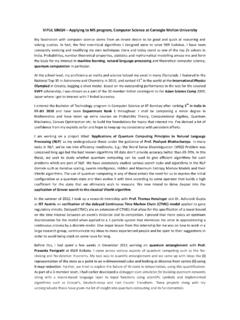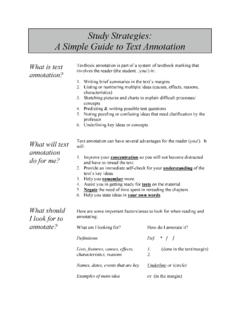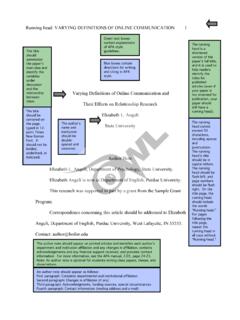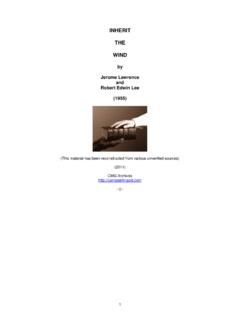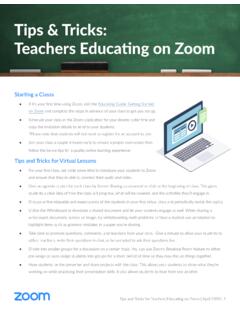Transcription of Project 3 - Assembly Drawings - Carnegie Mellon University
1 ME 24-688 Week 6. Project 3 Assembly Drawings Annotating Assembly Drawings Assembly Drawings typically include annotations that identify and describe the components in the Assembly . You can include balloons in your drawing views to identify specific parts, and then add a parts list to your drawing that includes a quantity and description for each component. In this chapter, you learn how to add balloons and a parts list to your Assembly Drawings , and how the bill of materials (BOM) is used to manage this type of information. 1. Bill of Materials A bill of materials is a table that Contains information about the parts within an Assembly . This can include quantities, names, costs, vendors, and all the other information someone building the Assembly might need. Reviewing and editing bill of materials (BOM) data is an important step toward communicating a completed design.
2 Knowing where and how to edit BOM data and being able to view just the right amount of data helps you in this review and edit process. In the illustration, the Bill of Materials editor is shown after enabling and editing the view of the Structured data to show all levels of the Assembly 's data. The Outsourced and Material columns were added to the display so that their data could be viewed and edited from this single location. ME 24-688 Introduction to CAD/CAE Tools Page 1 of 66. ME 24-688 Week 6. Project 3 Assembly Drawings About the Bill of Materials The bill of materials plays a significant role in collecting and managing the data that is displayed in a parts list on a drawing, or used by other software applications. In the illustration, a portion of the Bill of Materials dialog box displays some of the many columns with component information. You can specify which columns you want to view.
3 For columns that display specific component iProperty data, you can change the value in the cell and have the value change for the component as though you made the change in the iProperties dialog box. Definition of a Bill of Materials The concept of a bill of materials (BOM) means you have a single location where the data for the BOM. such as part number, item number, quantity, material, and so on, is stored. From that single location, you can edit the values in a BOM, use its data and structure to populate the information in balloons and parts lists placed on a drawing, and populate the data and structure for a material acquisition and resource planning program. The data stays synchronized between the balloons and parts lists on Drawings and the Assembly bill of materials. Because the BOM makes all the data for the Assembly accessible in a single location, you need different ways to interact with and present the data.
4 When viewing and editing the data in an Assembly , the Bill of Materials dialog box has three tabs that have different purposes for viewing, editing, and presenting the data. These three tabs are: Model Tree: Always active for display. This view is similar to the browser except each component is listed only once for each Assembly or subassembly it may be used in. You use it to edit properties including some editing functions that cannot be done in one of the other tabs, like changing properties for components whose BOM structure is set to Phantom or Reference. Structured: Use to display either just the top-level BOM data or all levels of BOM data. When displaying all levels of data, the data displays in a hierarchy structure. Each component has a unique item number and the components within a subassembly display the item number of the subassembly as a prefix to their item number.
5 You have the option of including a delimiter between the numbers. The hierarchy of components and item numbers is used in the parts lists and balloons that you place on the drawing sheet. An exported copy of this same data and structure can also be created. ME 24-688 Introduction to CAD/CAE Tools Page 2 of 66. ME 24-688 Week 6. Project 3 Assembly Drawings Parts Only: Use to display the BOM data for parts only. All subassemblies are ignored and the parts in those subassemblies are promoted to display as though they were directly placed in the toplevel Assembly instead of in a subassembly. Each part is also assigned a unique item number. You can use this display configuration for the parts list and balloons on the drawing sheet. This same data can also be exported for use by other software applications. Only the Model Tree tab is enabled at all times for selection and viewing of data.
6 The Structured tab and Parts Only tab can be enabled or disabled. By enabling only the tab you require, the amount of information to collect and the ways of presenting it in the Bill of Materials dialog box are less than if you enabled both tabs. Editing Tasks in the Bill of Materials In the Bill of Materials dialog box, you have the option to change the BOM data in many different ways. Some of the changes you can make include but are not limited to: Changing the order in which the components are displayed. Changing the order in which the columns of information are displayed. Changing which columns of information are displayed. Creating columns for custom iProperty data. Remembering the item numbers. Locking the item numbers so they cannot be changed. Changing the material property. Creating conditions for the merging of row data based on the same part numbers. Example of Bill of Materials Display In the illustration, the display of the BOM is currently set to display only the parts used in the Assembly .
7 A. list of these parts and the parts' information can be displayed on the drawing or exported for use in other software applications. Displaying and organizing the BOM data in this manner is especially useful if you only order and manufacture parts and do not require the listing of subassembly components. ME 24-688 Introduction to CAD/CAE Tools Page 3 of 66. ME 24-688 Week 6. Project 3 Assembly Drawings Access Ribbon: Assemble tab |Manage panel | Bill of Materials Browser shortcut menu on an Assembly or subassembly in a drawing file: Bill of Materials Editing iProperty Data When you change the data in any cell for a component, except in the QTY column, that change is written back to the iProperty value in that component file. Using this editing method, making changes from within the Assembly BOM is a powerful and efficient way to change data for many components. However, use caution when making your edits because those changes actually reside in the component file.
8 Thus any place that the component is used, the information changes there as well. You can add any property column to the display of the BOM by dragging and dropping the property column name from the Customization dialog box onto a column heading. You display the Customization dialog box by clicking Choose Columns on the toolbar. This dropped column is then added before the column it was dropped on. By adding the Material property column to the BOM, you can display and change the material property for a component. Just like the other properties, the material property changes in the part file when it is changed in the BOM. You can also assign a material value to a virtual component. In these cases, the material change is stored in the Assembly file where the virtual component resides. Note: After you assign a material and enter a volume for a virtual component, the mass of the component is calculated and available for reporting in the Mass property column.
9 ME 24-688 Introduction to CAD/CAE Tools Page 4 of 66. ME 24-688 Week 6. Project 3 Assembly Drawings In the illustration, a new column is being added to the Bill of Materials editor. The left image shows the new column being dragged into position. The right shows the Bill of Materials editor with the new column in place. To add a column for data that does not pertain to a preset property, on the toolbar, click Add Custom iProperty Columns. When you click this, the Add Custom iProperty Columns dialog box is displayed, where you enter a name for the property and select the type of data to be stored in the property. The custom iProperty column is then added to the far right end of the BOM. Like the other columns in the table, you can reorder its display by clicking and dragging its heading to the left or right. By specifying the name and data type of an existing custom iProperty, the existing data is automatically displayed in the cell.
10 If the custom iProperty name does not exist in a component, and you add data to this custom property column for the component, the custom iProperty is automatically added to the component file. Row Merging for Same-Part-Numbered Components When you have different part files with the same iProperty part number, you can control whether they are merged into a single item entry in the BOM. You turn on or off this functionality in the Part Number Row Merge Settings dialog box by checking or clearing the Enable Row Merge option in the Part Number Match dialog box. You access this dialog box by clicking Part Number Merge Settings on the toolbar. In this same dialog box, you can create a list of different exclusion strings. Enter the part number as the exclude string so that components with that part number are not merged together. When row merging has occurred, the icon to the left of that item number row is displayed as a blue rectangle stacked on top of a red rectangle.
